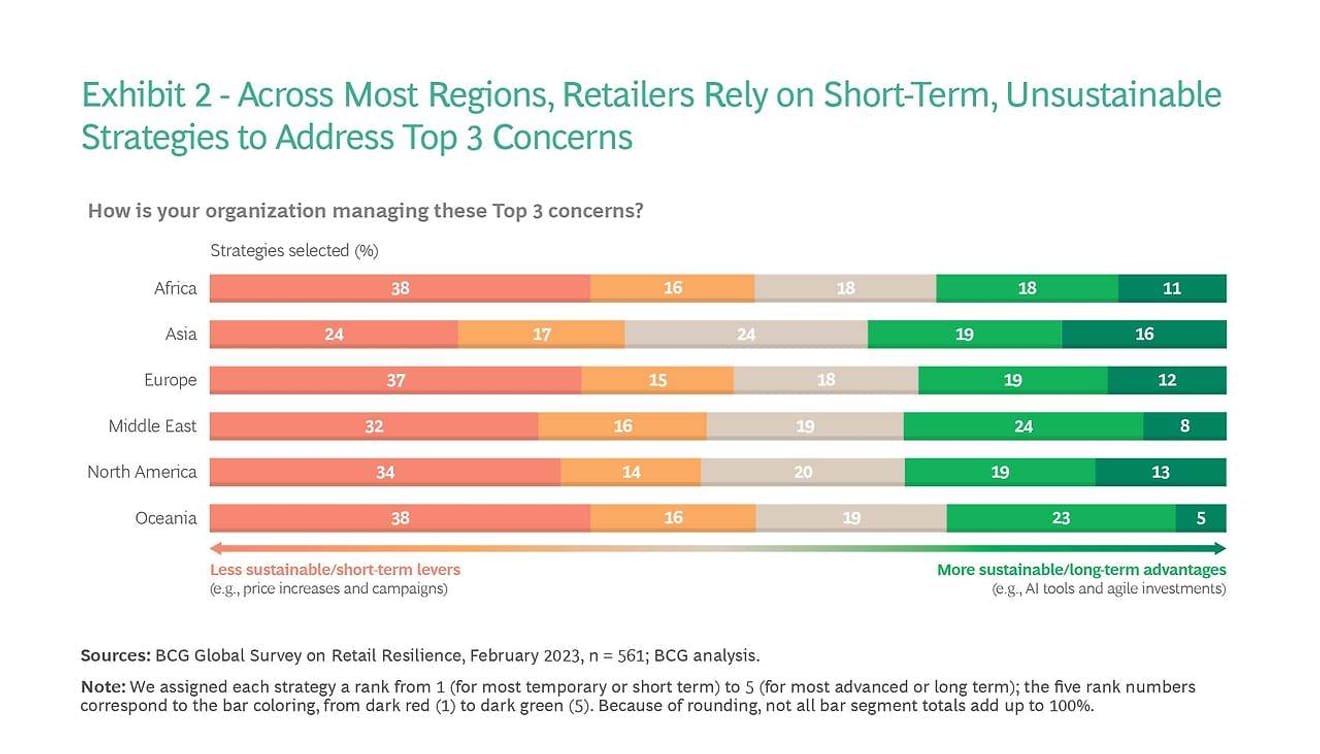Beach seasons opened early. The news of Haeundae Beach in Busan opening early on the 1st signifies that people are continuously seeking opportunities to go out following the endemic.

Amid Uncertainty, AI Gives Retailers a Path to Resilience / BCG
However, this hasn't translated into the same opportunities for businesses operating offline stores as before the pandemic. According to a report released by the Boston Consulting Group (BCG) in April, retail industry leaders across 12 sectors globally cited rising product costs, declining consumer spending, and supply chain volatility as factors hindering a return to pre-pandemic levels. Furthermore, industry leaders in nearly every region, including Africa, Asia, Europe, and North America, responded that they were addressing these negative market factors with short-term, unsustainable strategies that aren't like the ones they used previously. South Korea's top three department stores, facing a halt in revenge spending that had continued since last year due to high prices and a slump in consumption, are now investing hundreds of billions of won in renovating existing stores with a focus on experience provision.
Stores are open spaces where consumers and brands build relationships. During the pandemic, companies invested in digitizing their offline stores, and customers grew accustomed to the convenience of online shopping. Now, the two entities that build relationships have the chance to reconnect in the same physical space, but their expectations of each other have changed. A prime example is the growth of the offline contactless payment market. According to the ‘Domestic Payment Trends’ report released by the Bank of Korea, the amount spent using mobile payment services rose from KRW 449.2 billion in 2020 to KRW 732.6 billion in 2022. Apple Pay, launched in March, advertised that it allows consumers to select an even ‘faster payment’ option. Traditionally, the moment of ordering and paying was a valuable point for brands to connect with customers. However, this signifies that the strategic role of 'human interaction' that used to involve friendliness and empathy is fading. What new clues are needed to strengthen customer relationships in this shifting dynamic?
When we hear the word ‘sense of belonging’, we often think of family, friends, or close-knit groups. However, this is only a small part of showing where and how we belong. A sense of belonging can also be felt in a neighborhood coffee shop on a weekend morning or on the subway during the morning commute. Feeling anxious in an office building or government building, feeling depressed in a dark subway station, or feeling out of place in a high-end store or a trendy cocktail bar are all related to a sense of belonging.
Today, we gather around individuals more than institutions or organizations. Many institutions that provided a sense of belonging, such as a declining college enrollment rate or a lack of trust in government systems, have declined. People now have the ability to follow individuals at their fingertips and can feel like part of something by scrolling through Instagram at 2 AM. However, the moment they leave the screen, they're alone again. In 2021, South Korea's rate of social isolation was 18.9%, ranking among the highest among OECD member countries. With the absence of a sense of belonging emerging as a social concern following the endemic, we need to think more deliberately about the power of 'physical spaces' to amplify that sense of belonging. People are seeking new social opportunities offered by familiar places as a solution to the disconnect they've experienced over the past few years.
And brands can consider reopened stores as a 'benchmark for new strategies'.
However, the traditional approach of designing store environments with specific purposes in mind, such as inventory storage, checkout, and experience provision, has limitations. This arises within a hierarchical structure where the designer acts as the architect of the entire environment, aiming to create a perfect world where people carry out their intended activities.

In this regard, anthropologist Tim Ingold's ‘research on how people relate to the environment’ can offer valuable clues for developing stores that foster a sense of belonging. Ingold distinguished between physical environments and environments encoded with social meaning. He emphasizes the importance of environments having a degree of plasticity and individuals leaving their mark on them, becoming a key component in shaping their surroundings.
In essence, it refers to an ecological approach where both the organizer and surrounding members participate. In fan communities built around a specific musician's music, individuals form derivative communities centered on shared experiences rather than the artist who serves as the initial point of connection. They find meaning within those communities. Businesses can aim for this. In an interview with local media, Ben Valente, author of ‘Fans Have More Friends’, stated that fandom serves as a foundation for connecting with a larger world.
"Ultimately, what matters most isn't what happens on the field, but what happens in the stands or living rooms among those who are together. We want to feel like part of something, and we want to connect with the people around us."
*This article is the original content published in the Electronic Times named columnon June 13, 2023.
References
Comments0